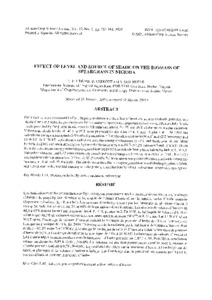| dc.contributor.author | Okogbenin, E. |
| dc.contributor.author | Ekanayake, I. |
| dc.contributor.author | Porto, M.C. |
| dc.date.accessioned | 2019-12-04T11:22:28Z |
| dc.date.available | 2019-12-04T11:22:28Z |
| dc.date.issued | 1999 |
| dc.identifier.citation | Okogbenin, E., Ekanayake, I.J. & Porto, M.C.M. (1999). Effect of planting methods and soil moisture on cassava performance in the semiarid Sudan savanna belt of Nigeria. African Crop Science Journal. 7, 21-33. |
| dc.identifier.issn | 1021-9730 |
| dc.identifier.uri | https://hdl.handle.net/20.500.12478/4012 |
| dc.description.abstract | Climatic and edaphic factors are important determinants of the growth and yield potential of an ecological environment. Among other cultural practices, planting methods play a very vital role in the performance of a crop. The effects of planting methods and soil moisture on cassava (Manihot esculenta) performance in the Sudan savanna region of Nigeria were assessed under field conditions at the International Institute of Tropical Agriculture (IITA) in Minjibir, Kano State. Six planting methods in monoculture were evaluated in two crop seasons. These were horizontal planting on furrow or ridge, inclined planting on flat or ridge, and vertical planting on flat or ridge.Two genotypes were compared: TMS 91934, an improved IITA clone; and Dakata Uwariya, a land race. Dakata Uwariya was significantly better (P < 0.05) than TMS 91934 in plant height and root dry matter content; TMS 91934 was better in leaf formation and leaf retention. Ridge-based methods positively influenced root yield production and leaf formation, while flat or furrow methods were advantageous in number of plants at harvest. Horizontal and inclined planting were the best methods in general. Results showed that cassava performance in the Sudan savanna of Nigeria was influenced by genotype, planting methods and soil moisture. Sustainable development of cassava in the semi-arid agroecology essentially depends on the use of clones with good drought adaptation, combined with efficient cultural practices for good growth and yield. |
| dc.language.iso | en |
| dc.subject | Manihot Esculenta |
| dc.subject | Planting Methods |
| dc.subject | Cassava |
| dc.subject | Leaf Formation |
| dc.subject | Leaf Retention |
| dc.subject | Root Dry Matter |
| dc.subject | Root Yield |
| dc.subject | Soil Moisture |
| dc.title | Effect of planting methods and soil moisture on cassava performance in the semiarid Sudan savanna belt of Nigeria |
| dc.type | Journal Article |
| dc.description.version | Peer Review |
| cg.contributor.affiliation | International Institute of Tropical Agriculture |
| cg.contributor.affiliation | Food and Agriculture Organization |
| cg.coverage.region | Africa |
| cg.coverage.region | West Africa |
| cg.coverage.country | Nigeria |
| cg.authorship.types | CGIAR and advanced research institute |
| cg.iitasubject | Cassava |
| cg.iitasubject | Soil Information |
| cg.iitasubject | Plant Production |
| cg.accessibilitystatus | Open Access |
| local.dspaceid | 99298 |

